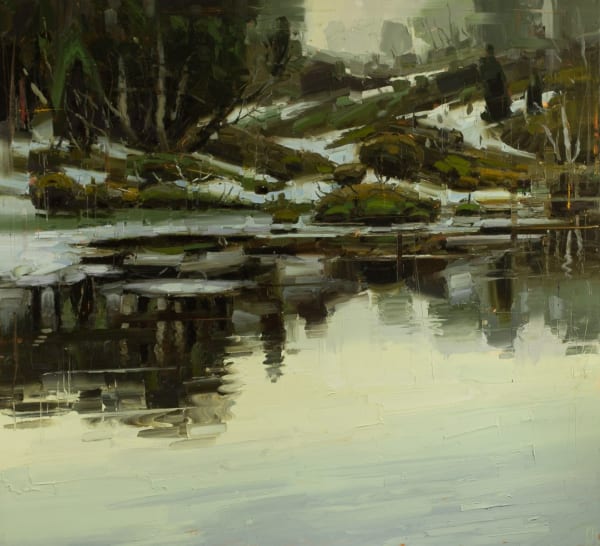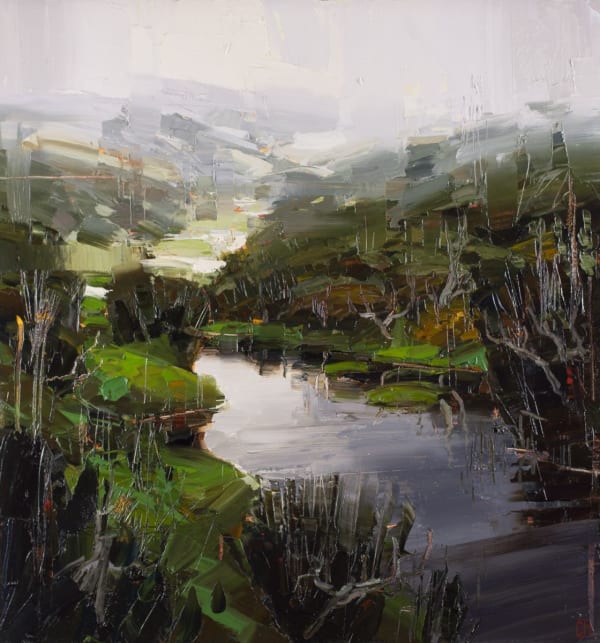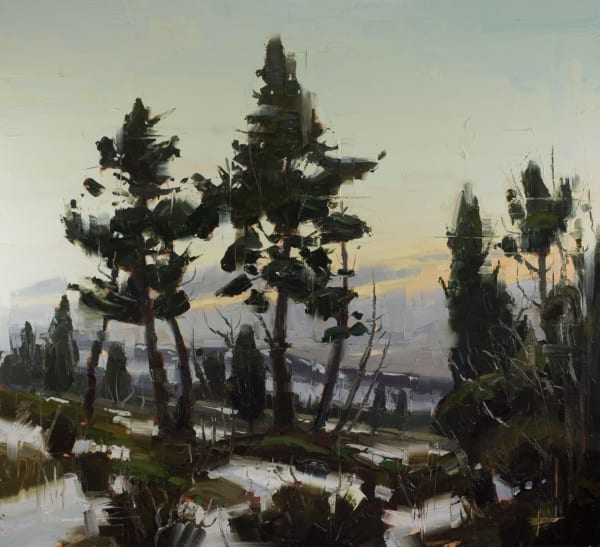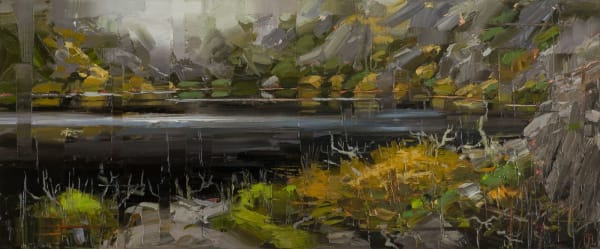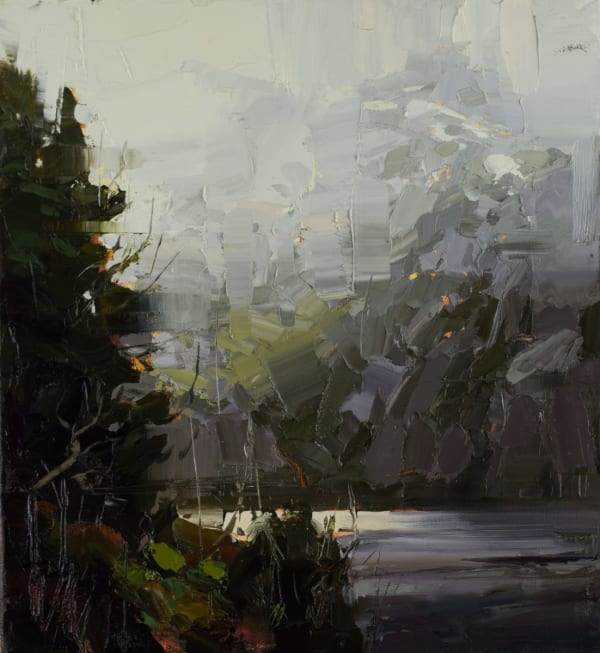Clifford How: Antipodean Light
-
 Clifford HowAs the Mist Cleared II, 2020oil on linen112 x 123 cm, 114 x 125 cm (framed)
Clifford HowAs the Mist Cleared II, 2020oil on linen112 x 123 cm, 114 x 125 cm (framed) -
 Clifford HowAutumn Ascent, Mt Murchison, 2020oil on linen112 x 123 cm, 114 x 125 cm (framed)
Clifford HowAutumn Ascent, Mt Murchison, 2020oil on linen112 x 123 cm, 114 x 125 cm (framed) -
 Clifford HowDawn Glow, 2020oil on linen153.5 x 168.5 cm, 156 x 171 cm (framed)
Clifford HowDawn Glow, 2020oil on linen153.5 x 168.5 cm, 156 x 171 cm (framed) -
 Clifford HowFrog Chorus II, 2020oil on linen86.5 x 81.5 cm, 90 x 84 cm (framed)
Clifford HowFrog Chorus II, 2020oil on linen86.5 x 81.5 cm, 90 x 84 cm (framed) -
 Clifford HowHidden Lake, 2020oil on linen62 x 56 cm, 64 x 59 cm (framed)
Clifford HowHidden Lake, 2020oil on linen62 x 56 cm, 64 x 59 cm (framed) -
 Clifford HowI Followed the Little Thread, 2020oil on linen138 x 153 cm, 140 x 156 cm (framed)
Clifford HowI Followed the Little Thread, 2020oil on linen138 x 153 cm, 140 x 156 cm (framed) -
 Clifford HowI Was Awoken By the Currawongs, 2020oil on linen153.5 x 168.5 cm, 156 x 171 cm (framed)
Clifford HowI Was Awoken By the Currawongs, 2020oil on linen153.5 x 168.5 cm, 156 x 171 cm (framed) -
 Clifford HowI Watched as the Ancient Face Disappeared, 2020oil on linen138 x 183.5 cm, 140 x 186 cm (framed)
Clifford HowI Watched as the Ancient Face Disappeared, 2020oil on linen138 x 183.5 cm, 140 x 186 cm (framed) -
 Clifford HowI Watched as the Sky Lifted, 2020oil on linen138 x 153.5 cm, 140 x 156 cm (framed)
Clifford HowI Watched as the Sky Lifted, 2020oil on linen138 x 153.5 cm, 140 x 156 cm (framed) -
 Clifford Howinto the Vale II, 2020oil on linen56.5 x 66 cm, 59 x 69 cm (framed)
Clifford Howinto the Vale II, 2020oil on linen56.5 x 66 cm, 59 x 69 cm (framed) -
 Clifford HowNestled Tarn, 2020oil on linen51 x 122.5 cm, 54 x 125 cm (framed)
Clifford HowNestled Tarn, 2020oil on linen51 x 122.5 cm, 54 x 125 cm (framed) -
 Clifford HowSanguine Shallows, 2020oil on linen137.5 x 168 cm, 140 x 171 cm (framed)
Clifford HowSanguine Shallows, 2020oil on linen137.5 x 168 cm, 140 x 171 cm (framed) -
 Clifford HowShimmer, Crater Lake, 2020oil on linen61.5 x 56.5 cm, 64 x 59 cm (framed)
Clifford HowShimmer, Crater Lake, 2020oil on linen61.5 x 56.5 cm, 64 x 59 cm (framed) -
 Clifford HowShoreline Traverse, 2020oil on linen51 x 122.5 cm, 54 x 125 cm (framed)
Clifford HowShoreline Traverse, 2020oil on linen51 x 122.5 cm, 54 x 125 cm (framed) -
 Clifford HowSoutherly Front, 2020oil on linen81.5 x 87 cm, 84 x 90 cm (framed)
Clifford HowSoutherly Front, 2020oil on linen81.5 x 87 cm, 84 x 90 cm (framed) -
 Clifford HowSummit Colour II, 2020oil on linen153.5 x 168.5 cm, 156 x 171 cm (framed)
Clifford HowSummit Colour II, 2020oil on linen153.5 x 168.5 cm, 156 x 171 cm (framed) -
 Clifford HowThe Air Was Filled With Light, Mt Murchison, 2020oil on linen66 x 56 cm, 69 x 59 cm (framed)
Clifford HowThe Air Was Filled With Light, Mt Murchison, 2020oil on linen66 x 56 cm, 69 x 59 cm (framed) -
 Clifford HowThe Ancient Tarn Held My Gaze, 2020oil on linen81.5 x 87 cm, 84 x 90 cm (framed)
Clifford HowThe Ancient Tarn Held My Gaze, 2020oil on linen81.5 x 87 cm, 84 x 90 cm (framed) -
 Clifford HowThe Concealed Place, 2020oil on linen56 x 61.5 cm, 59 x 64 cm (framed)
Clifford HowThe Concealed Place, 2020oil on linen56 x 61.5 cm, 59 x 64 cm (framed) -
 Clifford HowThe Land and Sky Seemed to Coalesce, 2020oil on linen112.5 x 122.5 cm, 114 x 125 cm (framed)
Clifford HowThe Land and Sky Seemed to Coalesce, 2020oil on linen112.5 x 122.5 cm, 114 x 125 cm (framed) -
 Clifford HowThe Silence Was Broken, 2020oil on linen51 x 122.5 cm, 54 x 125 cm (framed)
Clifford HowThe Silence Was Broken, 2020oil on linen51 x 122.5 cm, 54 x 125 cm (framed) -
 Clifford HowWall Reflection, 2020oil on linen153.5 x 168.5 cm, 156 x 171 cm (framed)
Clifford HowWall Reflection, 2020oil on linen153.5 x 168.5 cm, 156 x 171 cm (framed) -
 Clifford HowWinter's Departure on Cradle Plateau, 2020oil on linen153.5 x 168.5 cm, 156 x 171 cm (framed)
Clifford HowWinter's Departure on Cradle Plateau, 2020oil on linen153.5 x 168.5 cm, 156 x 171 cm (framed)
Clifford How’s ‘Antipodean Light’ invites viewers on a solitary traverse across Tasmania’s north-western alpine wilds. The paintings are a visual ode to an environment dear to the artist’s heart. As a fourth-generation Tasmanian, How’s family hails from the Central Plateau region, where he spent much of his youth. After a decade working as a floor-sander in Melbourne, How was drawn back to the island in 2009. As he revisited places experienced as a child, he felt compelled to capture them artistically and began painstakingly reading about and experimenting with painting. A self-taught painter, How has arrived at a thoroughly idiosyncratic style that he describes as ‘organic abstraction’. Pigments are deployed fervently and intuitively via palette knife, conveying the primeval wildness of the Tasmanian landscape.
The genre of landscape painting is historically entangled with colonial and imperial ideals, whereby the subjugated landscape silently boasted of a subjugated people. How effectively re-wilds the genre, by ceding control and permitting scenes to spill out of frame and bulge from the canvas, barely contained. These are not manicured pastures or postcard images - we are not spared the mud and the mist. The landscapes are not overtly recognisable - a deliberate strategy employed by the artist to avoid the pitfall of hollow sentimentality overwhelming the evocative. By exaggerating and manipulating scenes captured as en plein air studies, the drama is amplified and a dream-like mood sets in.
The intensity and volatility of Tasmania’s weather cannot be understated. The artist explains that ‘weather rolls in and changes the feeling of a place’ and that the overriding drive of the series was a desire to ‘enable people to feel that, who hadn’t experienced it before’. Moments of stillness, flux and fury are rendered with profound sensitivity, sustained by a mastery of light. Dawn glow deftly recreates the oily opalescence of a tarn at first light, whilst Southerly front captures the intensity of a low-pressure system sweeping across a plateau, the downpour gently illuminated in the distance. Winters departure on Cradle Mountain signifies the changing of the seasons - a gentle stream of snowmelt guides the viewers’ eyes across a drenched and dormant ridge. The weather and the terrain are inextricably linked. How describes the landforms and flora as having been ‘brought to life and battered into shape by eons of weather patterns’. This relationship is discernible in such works as The land and the sky seemed to coalesce and I watched as the ancient face disappeared, where earth and sky melt into one another.
There is a poetry to How’s titles that generously expands the experience of his paintings. For the ‘Antipodean Light’ series, he introduced a novel naming convention, referencing sounds as a means of creating multi-dimensionality. ‘I found that adding to the pure visuals allowed another sense to kick in, bringing the scenes to life‘, How explains. In I was awoken by the currawongs and Frog chorus II, the songs of unseen creatures are evoked, effectively transporting the viewer to a palpable, intimate moment in nature. The silence was broken animates the scene of a cascading waterfall with recollections of crashing water and the fragrant, damp atmosphere of the Tasmanian rainforest. The viewer experiences an upwelling of nostalgia for a place they’ve never been.
The ‘Antipodean Light’ paintings possess a grounding and restorative quality. The environments are consciously devoid of people or human intervention, lending a timelessness that expresses a quiet and ancient power. The works are a meditation on our place in nature. How reflects that ‘we are quite small in the scheme of things and these places will exist beyond us’. They must be cherished and protected.
Pippa Mott
Curator and Arts Writer


